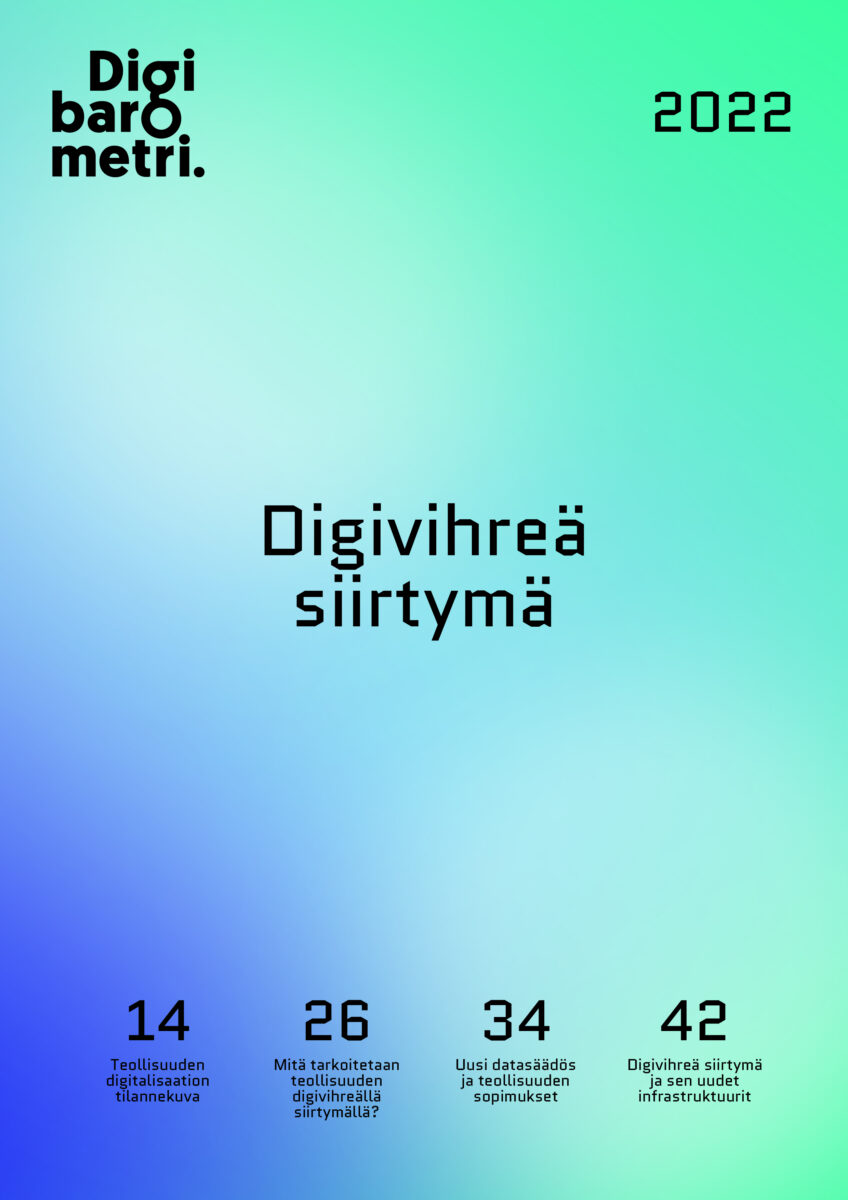
Vuosina 2014–2022 julkaistut digibarometrit ovat kertoneet kansakunnan digitaalisen asennon sekä siinä tapahtuneet muutokset myös suhteessa muihin maihin. Näin on jälleen tänäkin vuonna. Perinteisen digibarometrin tulokset ja havainnot löytyvät julkaisun alun tiivistelmästä ja liitteestä 3. Jo viidettä kertaa muu osuus Digibarometri-julkaisusta rakentuu yhden pääteeman ympärille. Tänä vuonna teemaksi on valittu ”Digivihreä siirtymä”.
Aiempien digibarometrien perusteella tiedämme, että heräämisensä jälkeen Suomi kiri itsensä vertailun kärkisijoille. Vuoden 2022 tuloksista on havaittavissa, että digitalisaation vaikutukset Suomalaisiin yrityksiin ovat heikkenemässä, kansalaisten vertailussa ollaan tasaisesti kärkikastissa ja julkisen sektorin vertailussa Suomi tippui toiseksi.
Vuoden 2022 teema määrittelee digitalisaation, vihreän siirtymän ja digivihreän siirtymän käsitteet ja kuvaa niiden kehitystä Suomen teollisuuden näkökulmasta. Tässä Digibarometrissa digivihreällä siirtymällä tarkoitetaan siirtymää digitaalisiin teknologioihin, jotka edesauttavat ja tehostavat vihreää siirtymää, nopeuttavat siirtymistä pois fossiilisesta energiasta ja eri energiamuotojen keskinäistä ristiin kompensointia.
Timo Seppälän esityskalvot Digibarometri 2022 julkistustilaisuudessa 14.6.2022
Finland ranks second in Digibarometer 2022, which compares 22 countries with a composite index consisting of 36 variables. The ranking is the same as in the last year. Also, Denmark is in the first place as in the last year. Norway rises from its last year’s fourth place to the third place. The United States is in the fourth position, the Netherlands in the fifth and Sweden leaps from the third place to sixth. The bottom of the list is once again occupied by Brazil, Italy, and Russia.
Digibarometer is a study which evaluates how well individual countries utilize digitalization and how they compare to one another in this respect. It measures the utilization of digital capabilities. In other words, general factors such as educational levels or a country’s role as a producer of ICT, for example, do not affect the scoring. The measurement is done on three levels (capabilities, utilization, and implications) and across three sectors (company, civic, and public). Each sector is examined on each level, thus forming a scoring matrix of nine cells for each country.
Finland has been among the three best countries in the Digibarometer during the nine years it has been carried out. It has even held the lead once, in 2016. Finland’s high placement is explained by its even performance across various indicators. Finland’s capabilities to utilize digitalization are among the best in the world as well as the actual utilization (3th place). Regarding implications (6th), however, Finland scores lower. Earlier on, the company sector has been Finland’s leading digital sector. Now the position of the Finnish companies is slightly waning in the international comparison (4th this year). The public sector loses one position in the ranking but still scores excellently (2nd). In the civic sector, Finland ranks also well and is in the fourth place.
Arkadiankatu 23 B
00100 HELSINKI
Vaihde ja vastaanotto avoinna arkisin klo 8.30–15:30.
+358 (09) 609 900